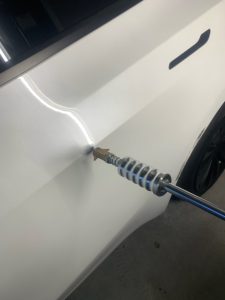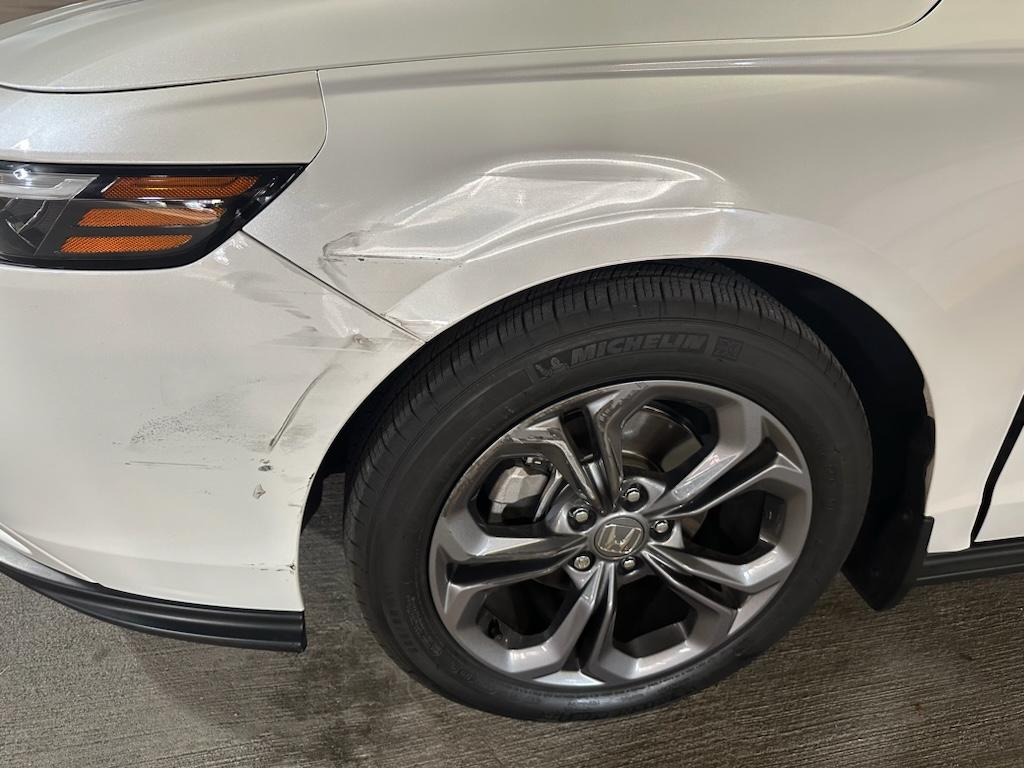Paintless Dent Repair (PDR) has become a revolutionary solution for addressing small vehicular dents and dings. For years, experts repaired damaged panels by accessing their backsides and performing manual metal manipulation. The technique applies to both hard-to-access areas and those that are completely unreachable.
What Exactly Is Glue Pulling?
Glue pulling operates differently since it performs its work from the outside instead of the conventional pushing motion from behind. Glue pulling operates with an effortless, basic principle but accomplishes complex results in the field. Here’s the basic process:
- Surface preparation: All dented surface areas go through a deep cleaning operation before continuing. Proper preparation of surfaces becomes vital because it guarantees a solid bond between materials.
- Tab selection: The selection of tabs (made from plastic and available in different shapes and sizes) happens according to dent characteristics.
- Glue application: The application of hot glue, specially made for PDR, requires high-strength bonding to the tab.
- Cooling and curing: Cooling is followed by curing, as the glue needs enough time to bond with the panel. A solid connection forms due to this process.
- Pulling process: The pulling motion activates all the repair work. Specialized pulling tools, like a slide hammer, mini-lifter, or pulling bridge, enable the pulling of dents by applying controlled force to the tab.
- Tab removal: The technician removes the dent tab through a procedure of multiple pulls until reaching the intended dent level, followed by a gentle twisting motion or a release agent application. The residual glue can be cleaned off without any difficulty.
Why is Glue Pulling Such a Big Deal?

Glue pulling isn’t just a niche technique; it’s becoming a core component of modern PDR. Here’s why:
- Universal access: Accessing all serviceable areas stands as the first major benefit. Glue pulling doesn’t care if there’s bracing, a double panel, or sound-deadening material blocking access from behind. It enables restoration on any external panel.
- Preserves factory finish: Glue pulling, alongside PDR, maintains the original factory finish by abstaining from paint and filler applications. This protects the vehicle’s value significantly while eliminating color-matching complications.
- Faster repairs: The method delivers faster repair times in numerous cases, especially while working on inaccessible dents. Vehicle owners benefit from reduced downtime and frequently experience reduced repair expenses.
- Less invasive: Because you’re not working behind the panel, there’s less risk of accidentally damaging wiring, clips, or other internal components.
- Continuous advancements: Glue pulling technology receives continuous advancements through improvements in both technologies and pulling techniques. Artificial advancements in tab designs, coupled with glue development and pulling tool mechanics, drive the push for boundless possibilities in the industry.
It’s Not Always the Answer, Though…
The technique alone does not fix every dent situation. The flexible nature of glue pulling means it applies to diverse dent types, but not all of them. You need to understand the situations in which this technique cannot work.
Limitations of Glue Pulling
- Deep, sharp dents: Glue pulling finds limited success on deeply dented surfaces that have very pointed or creased shapes. A defect may result from too extensive stretching of the metal. The finishing procedure may require traditional PDR methods when glue pulling reaches its boundaries.
- Poor paint condition: Glue pulling functions successfully as long as the technician maintains a strong bond between the glue and paint material. Existing damaged or insufficient paint condition poses a risk because glue pulling might detach the paint, so that repairs become more complex.
- Requires expertise: Experience, combined with a proper understanding of metal, allows skilled technicians to perform glue pulling effectively. Regular automobile drivers cannot perform this repair on their own. Experts understand the right amount of pulling force, which they execute to prevent ruining the metal structure.
The Future of Glue Pulling
The use of glue pulling shows no signs of disappearing from the automotive industry. The improved grip of glue pulling will extend PDR repair capabilities to handle more challenging dents, which leads to both less expense and rapid repairs.
The Bottom Line
Glue pulling functions as a robust tool within the PDR arsenal. With glue pulling technology, we can now repair more damage that traditional mechanics would normally dismiss. Given a dent you thought had no cure, you should consider glue pulling as a repair possibility. Identify a reliable PDR expert who specializes in glue pulling techniques to examine your vehicle. The outcome is a delightful surprise to many people.
Frequently Asked Questions
How does glue pulling work?
The process involves cleaning the dented area, applying high-strength glue to a plastic tab, placing the tab on the dent, and then using pulling tools (like a slide hammer or mini-lifter) to lift the dent outward. Once the dent is lifted, the tab is removed and any glue residue is cleaned off.
Is it safe for my car’s paint?
Yes. As long as the paint is in good condition, this method preserves the original factory finish and avoids repainting or fillers.
Can it fix any type of dent?
Not all dents qualify. It’s most effective on shallow, round dents. Deep, creased, or sharp ones might need a combination of techniques for full restoration.
What are the main benefits?
It’s non-invasive, works on hard-to-reach areas, maintains your car’s original paint, reduces repair time, and often lowers overall costs.
Is it better than traditional dent repair?
Each method has its strengths. This approach is faster and less invasive for minor to moderate damage, while traditional repairs are better for severe dents.
Can I do this at home?
It’s not recommended. Proper repair requires experience, the right tools, and an understanding of how metal reacts to force. Improper use could cause further damage.
What areas of the vehicle can be treated this way?
It’s versatile enough to work on most external panels—even those blocked by structural elements or internal components.
